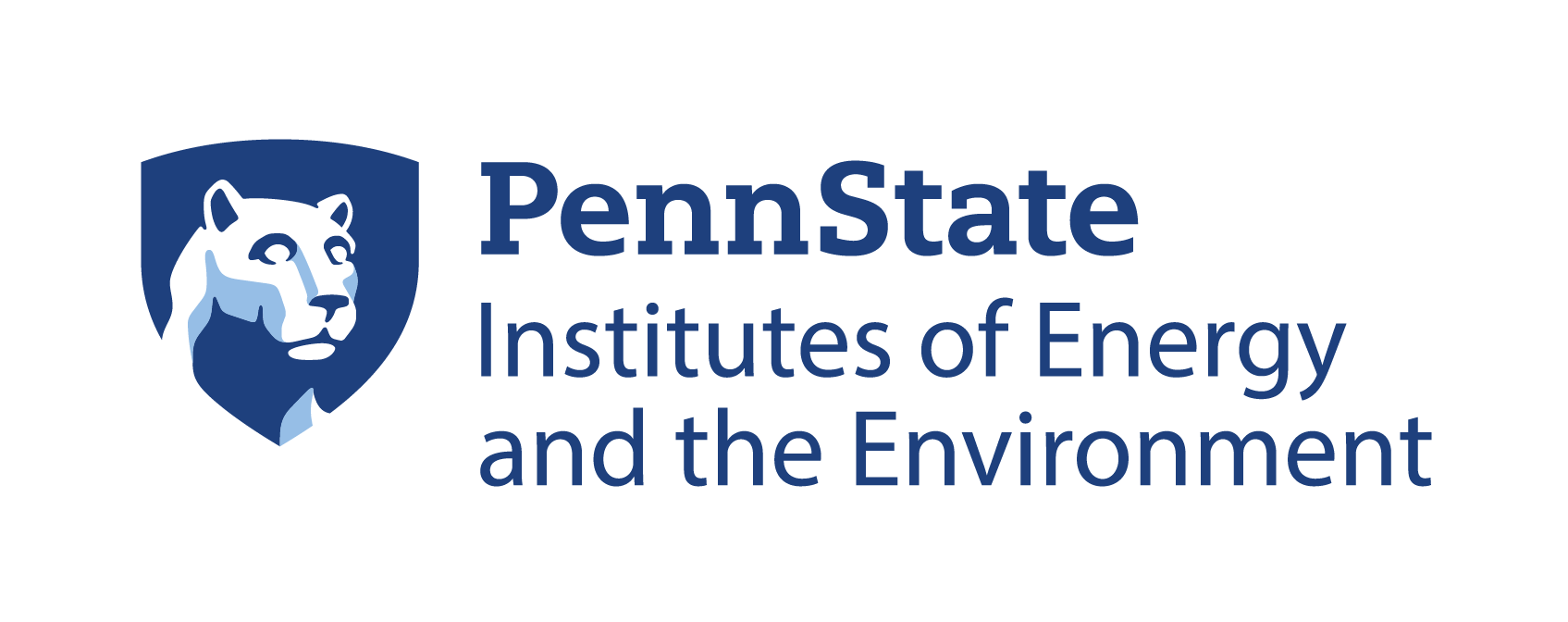Conference Program
Program Overview
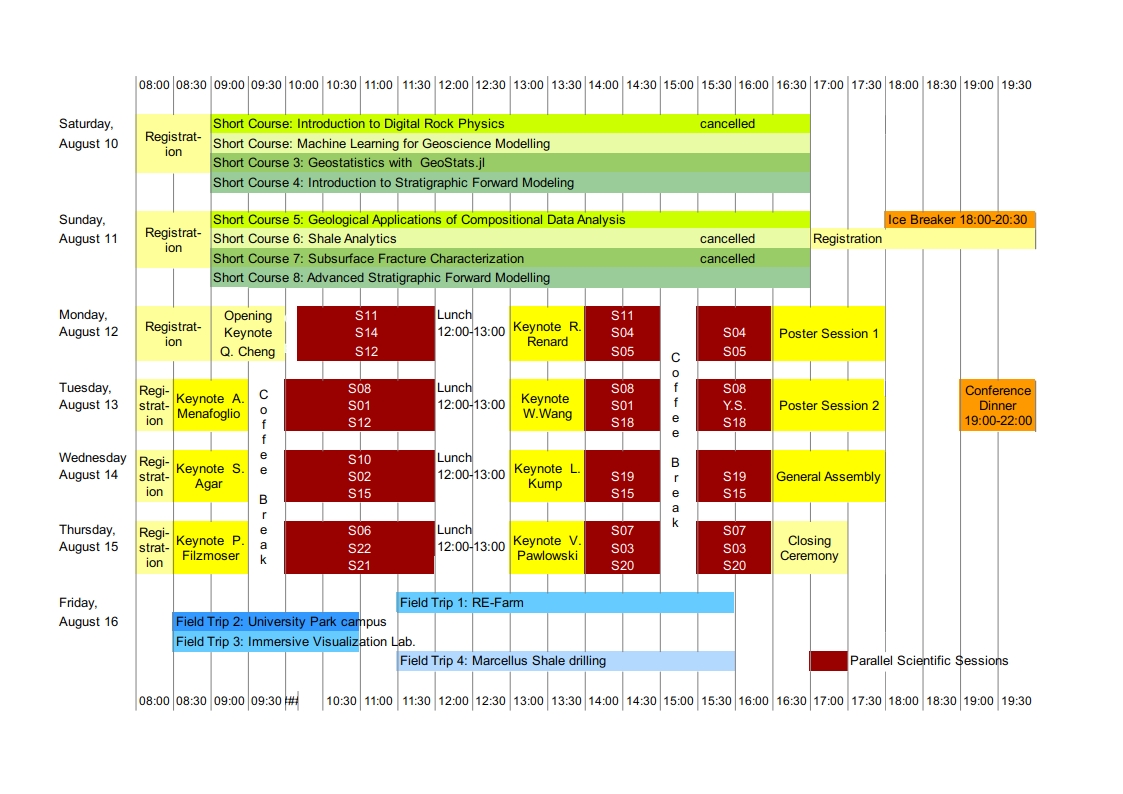
Download as pdf here.
| Session ID | Session Name | Session ID | Session Name |
|---|---|---|---|
| S01 | Classical Geostatistics | S11 | Machine Learning and Optimization Methods |
| S02 | Classical Statistics | S12 | Marine Geosciences: Coasts and Gateways |
| S03 | Compositional Data Analysis | S14 | Mining modeling |
| S04 | Fractal and Multifractal Modeling | S15 | Unconventional oil and gas resources modeling |
| S05 | Geohydrology | S18 | Analysis, Simulation, and Optimization of Subsurface Systems |
| S06 | Geoinformatics | S19 | Fracture Characterization and Modeling |
| S07 | Geometry and Topology in Geosciences | S20 | Coupling Geomechanics and Flow Systems in Subsurface Applications |
| S08 | Geophysical Data Processing, Interpretation and Machine Learning | S21 | Atmospheric and Earth System Science |
| S10 | Coupled Modeling of Food, Water and Energy Systems | S22 | Multiple Point Statistics |
Keynote Speakers
Susan M. Agar
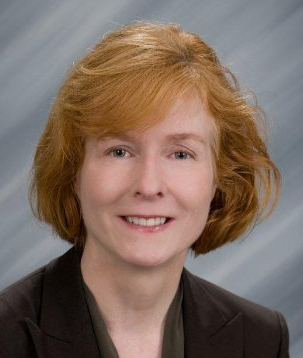 Dr. Susan Agar is a leader for innovations in geoscience at the Aramco Global Research Center in Houston. In this role, she steers research for subsurface technologies destined to support geoscientists of the future in Saudi Aramco. During 20-plus years in industry, she has contributed through various research leadership and senior advisory roles in leading global energy companies, pursuing research, teaching and consulting in over 25 countries. Before joining Aramco in 2014, she defined and led the ExxonMobil (FC)2 Alliance, a multi-national, multi-disciplinary academic-industry alliance involving 160 researchers and industry professional in 14 universities in N. America and Europe. She also led initiatives related to emerging and disruptive technologies and evaluations of the global gas endowment as represented in the ExxonMobil Energy Outlook. Prior to her industry career, Dr. Agar was a tenured faculty member at Northwestern University and a visiting faculty member at Stanford University. She holds a Ph.D. from Imperial College, an MBA degree from the Wharton School at the University of Pennsylvania. In 2016, she received an Honorary Doctorate of Science from Heriot Watt University in recognition for her outstanding contributions to reservoir engineering and petroleum geoscience and was recently a finalist for the “Innovative Thinker” at the World Oil Awards.
Dr. Susan Agar is a leader for innovations in geoscience at the Aramco Global Research Center in Houston. In this role, she steers research for subsurface technologies destined to support geoscientists of the future in Saudi Aramco. During 20-plus years in industry, she has contributed through various research leadership and senior advisory roles in leading global energy companies, pursuing research, teaching and consulting in over 25 countries. Before joining Aramco in 2014, she defined and led the ExxonMobil (FC)2 Alliance, a multi-national, multi-disciplinary academic-industry alliance involving 160 researchers and industry professional in 14 universities in N. America and Europe. She also led initiatives related to emerging and disruptive technologies and evaluations of the global gas endowment as represented in the ExxonMobil Energy Outlook. Prior to her industry career, Dr. Agar was a tenured faculty member at Northwestern University and a visiting faculty member at Stanford University. She holds a Ph.D. from Imperial College, an MBA degree from the Wharton School at the University of Pennsylvania. In 2016, she received an Honorary Doctorate of Science from Heriot Watt University in recognition for her outstanding contributions to reservoir engineering and petroleum geoscience and was recently a finalist for the “Innovative Thinker” at the World Oil Awards.
Talk title: Driving Rapid Transformations in the Energy Industry: the Convergence of Emerging Technologies and Mathematical Geoscience
Scheduled: Wednesday 13:00
Qiuming Cheng
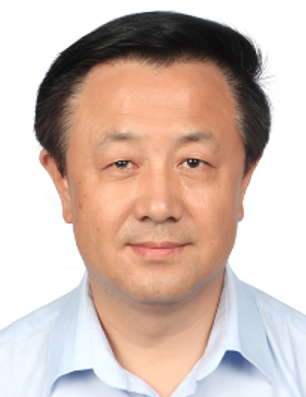 Qiuming received his PhD in Earth Sciences from the Department of Earth Science, University of Ottawa in 1994. After one year of PDF at the Geological Survey of Canada, Qiuming became an assistant professor and then promoted to full professor in 2002 at York University, Toronto, Canada with cross appointments in the Department of Earth and Space Science and Engineering, and the Department of Geography. Currently he is a Thousand Talent National Special Professor of China University of Geosciences (Beijing) serving as the founding director of the State Key Lab of Geological Processes and Mineral Resources. Qiuming’s primary research interest involves the interdisciplinary study of non-linear properties of the Earth’s systems as well as quantitative assessment and prediction of natural resources and environmental impacts. His research on the new local singularity analysis theory and geomathematical models have made major impacts in several geoscientific disciplines, including prediction of deeply buried mineral deposits and modelling hydrothermal mineralization, ocean ridge heat flow, and magmatic flare-up during crustal growth. He has published more than 250 refereed papers and 17 book chapters, delivered over 100 invited and keynote presentations worldwide. He has received several prestigious awards including the William Christian Krumbein Medal, the highest award given by International Association for Mathematical Geosciences, the Canada Foundation for Innovation Award, and the State Science and Technology Award of the Chinese Government.
Qiuming received his PhD in Earth Sciences from the Department of Earth Science, University of Ottawa in 1994. After one year of PDF at the Geological Survey of Canada, Qiuming became an assistant professor and then promoted to full professor in 2002 at York University, Toronto, Canada with cross appointments in the Department of Earth and Space Science and Engineering, and the Department of Geography. Currently he is a Thousand Talent National Special Professor of China University of Geosciences (Beijing) serving as the founding director of the State Key Lab of Geological Processes and Mineral Resources. Qiuming’s primary research interest involves the interdisciplinary study of non-linear properties of the Earth’s systems as well as quantitative assessment and prediction of natural resources and environmental impacts. His research on the new local singularity analysis theory and geomathematical models have made major impacts in several geoscientific disciplines, including prediction of deeply buried mineral deposits and modelling hydrothermal mineralization, ocean ridge heat flow, and magmatic flare-up during crustal growth. He has published more than 250 refereed papers and 17 book chapters, delivered over 100 invited and keynote presentations worldwide. He has received several prestigious awards including the William Christian Krumbein Medal, the highest award given by International Association for Mathematical Geosciences, the Canada Foundation for Innovation Award, and the State Science and Technology Award of the Chinese Government.
Qiuming is the past president of the International Association for Mathematical Geosciences (IAMG). The current president of the International Union of Geological Sciences (IUGS). IUGS is one of the largest unions in geosciences representing a million earth scientists from more than a hundred nations, and 58 affiliated international associations.
Talk title: Deep-time Digital Earth (DDE) Big Science Program: opportunity for mathematical and data geoscientists
Scheduled: In the Opening Ceremony
Peter Filzmoser
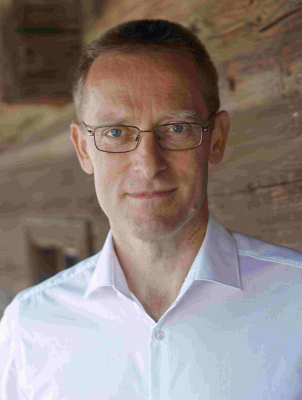 Peter Filzmoser is full professor at the statistics department of the Vienna
University of Technology. His main research interests include robust statistics, methods
for compositional data analysis, statistical computing with R, and many more. He is
author of the books: "Applied Compositional Data Analysis. With Worked Examples in R
(Springer 2018), "Introduction to Multivariate Statistical Analysis in Chemometrics"
(CRC Press, 2009), and "Statistical Data Analysis Explained. Applied Environmental statistics
with R (Wiley, 2008). Currently, he is head of the Research Unit in Computational Statistics,
Institute of Statistics and Mathematical Methods in Economics, Vienna University of Technology.
Peter Filzmoser is full professor at the statistics department of the Vienna
University of Technology. His main research interests include robust statistics, methods
for compositional data analysis, statistical computing with R, and many more. He is
author of the books: "Applied Compositional Data Analysis. With Worked Examples in R
(Springer 2018), "Introduction to Multivariate Statistical Analysis in Chemometrics"
(CRC Press, 2009), and "Statistical Data Analysis Explained. Applied Environmental statistics
with R (Wiley, 2008). Currently, he is head of the Research Unit in Computational Statistics,
Institute of Statistics and Mathematical Methods in Economics, Vienna University of Technology.
Talk title: Outliers and compositional data
Scheduled: Thursday 08:30
Lee Kump
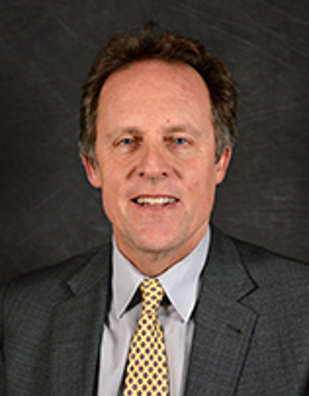 Lee Kump was named the seventeenth dean of the College of Earth and Mineral Sciences in 2017.
Kump joined Penn State's faculty in 1986. He specializes in atmosphere and ocean evolution, environmental biogeochemistry, and biogeochemical cycles. Throughout his career, Kump has been an advocate for the scientific study of the Earth and environment and has focused his research on understanding the forces at work behind climate change throughout history. His current research projects include the study of atmospheric oxygen levels, dynamics of the sedimentary record, paleoclimate data assimilation for deep time, and the modeling of Earth’s dynamic systems.
Lee Kump was named the seventeenth dean of the College of Earth and Mineral Sciences in 2017.
Kump joined Penn State's faculty in 1986. He specializes in atmosphere and ocean evolution, environmental biogeochemistry, and biogeochemical cycles. Throughout his career, Kump has been an advocate for the scientific study of the Earth and environment and has focused his research on understanding the forces at work behind climate change throughout history. His current research projects include the study of atmospheric oxygen levels, dynamics of the sedimentary record, paleoclimate data assimilation for deep time, and the modeling of Earth’s dynamic systems.
Kump is a fellow of the American Geophysical Union, Geochemical Society, European Association of Geochemistry, Geological Society of London, and the Geological Society of America. Kump is the co-author of “Dire Predictions: Understanding Climate Change,” which was published in 2016, and breaks down the findings from the Intergovernmental Panel on Climate Change. He is lead author of the popular textbook “The Earth System” and a co-author of a textbook on numerical modeling. In addition, Kump has been an editor or editorial board member for such science journals as Geology, Science and Nature Scientific Reports, and he currently is on the editorial committee for the Annual Reviews of Earth and Planetary Sciences journal.
During his time at Penn State, he has led a variety of research projects with the Environmental Protection Agency, NSF and NASA, among others. Kump earned a doctorate in marine sciences from the University of South Florida and a bachelor’s degree in geophysical sciences from the University of Chicago.
Talk title: Simple models for complex problems: a lighthearted examination of my attempts at Earth system modeling
Scheduled: Wednesday 13:00
Alessandra Menafoglio
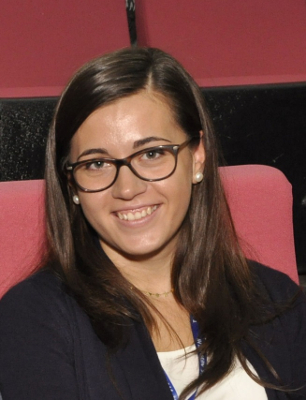 Alessandra Menafoglio is an Assistant Professor in Statistics at the Department of Mathematics of the Politecnico di Milano, within the laboratory for modeling and scientific computing (MOX). Her research interests focus on the study of innovative statistical models and methods for the analysis of complex and large data (such as curves and images), with particular emphasis on spatially distributed complex data. In the last years, she focused on the problems of modeling, prediction (kriging) and stochastic simulation for very general types of data, in the context of Object Oriented Spatial Statistics. More recently, she also investigated computational intensive methods to address the issues arising when the data objects are distributed over irregularly shaped and textured regions. Alessandra Menafoglio obtained her PhD in Mathematical Models and Methods in Engineering in 2015 at Politecnico di Milano. Her doctoral thesis was awarded in 2016 with the "Eni Award, Debut in Research Prize". She is first author of the 2016 Editor Choice Award winner of the journal Water Resources Research. In 2018, she was awarded the "2018 Young Statistician Award" given by the ENBIS Scientific Society (European Network for Business and Industrial Statistics).
Alessandra Menafoglio is an Assistant Professor in Statistics at the Department of Mathematics of the Politecnico di Milano, within the laboratory for modeling and scientific computing (MOX). Her research interests focus on the study of innovative statistical models and methods for the analysis of complex and large data (such as curves and images), with particular emphasis on spatially distributed complex data. In the last years, she focused on the problems of modeling, prediction (kriging) and stochastic simulation for very general types of data, in the context of Object Oriented Spatial Statistics. More recently, she also investigated computational intensive methods to address the issues arising when the data objects are distributed over irregularly shaped and textured regions. Alessandra Menafoglio obtained her PhD in Mathematical Models and Methods in Engineering in 2015 at Politecnico di Milano. Her doctoral thesis was awarded in 2016 with the "Eni Award, Debut in Research Prize". She is first author of the 2016 Editor Choice Award winner of the journal Water Resources Research. In 2018, she was awarded the "2018 Young Statistician Award" given by the ENBIS Scientific Society (European Network for Business and Industrial Statistics).
Talk title: Object Oriented Spatial Statistics: an approach to the analysis of georeferenced complex data
Scheduled: Tuesday 08:30
Vera Pawlowsky-Glahn
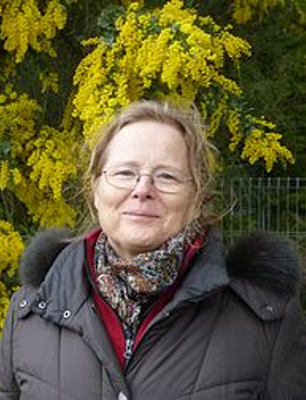
Dr. Vera Pawlowsky-Glahn studied Mathematics at the University of Barcelona, Spain, and received her PhD (doctor rerum naturam) in 1986 from the Free University of Berlin, Germany. She has been titular professor at the School of Civil Engineering of the Technical University of Catalonia (UPC) in Barcelona, Spain (1986-2000), and full professor of Statistics at the Department of Computer Science, Applied Mathematics, and Statistics of the University of Girona, Spain (2001-2018). Since October 2018 she is emeritus professor of Statistics at the University of Girona, Spain. Her main research topic is, since 1982, the statistical analysis of compositional data (CoDa) both in the spatial and non-spatial case. She developed together with Dr. J.J. Egozcue the sample space structure to CoDa. The impact of the methodology has grown exponentially in the last years, as CoDa are present in all applied sciences. She has over 120 publications and 3 books related to this topic. Her research group on compositional data analysis involves professors from different Spanish universities. They started a workshop series, known as CoDaWork, which 8th edition will take place in 2019 in Terrassa (Spain). Her research has received regularly financial support from the Spanish Ministry for Education and Science. Vera has been vice-chancellor at UPC 1990-1994, head of the Department of Computer Science and Applied Mathematics at the University of Girona 2004-2005, and dean of the Graduate School of the University of Girona 2005−06. The International Association for Mathematical Geosciences (IAMG) has been an important professional society in her career, supporting and promoting her research. She received from IAMG the William Christian Krumbein Medal in 2006, she was Distinguished Lecturer in 2007, and received the J.C. Griffiths Teaching Award in 2008. She was the 2008−2012 President and the 2012−2016 Past-President of IAMG. She was the founding President of the Association for Compositional Data (L’Escala (Spain), 2015), and is the 2017-2021 Past-President of the same association. She has been elected the 2019 IAMG Matheron Lecturer.
Talk title: Compositional data in geostatistics
Scheduled: Thursday 13:00
Phillipe Renard
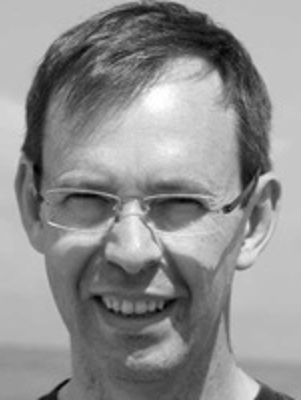 Dr. Philippe Renard is Associate Professor
of Hydrogeology at the University of
Neuchatel Switzerland where he leads
the Stochastic Hydrogeology Group. He
graduated from the Nancy School of Geology in Nancy,
France and obtained his PhD from Paris School of Mines
in 1996. His research focuses on stochastic hydrogeology
and aquifer. In geostatistics, he has developed multiple-
point statistics methods and their applications to a wide
range of problems from 3-D geological modeling to the
simulation of climate variables. Renard has been the editor
of Hydrogeology Journal, president of the geoENVia
association and manages the Hydrogeologist Time
Capsule.
Dr. Philippe Renard is Associate Professor
of Hydrogeology at the University of
Neuchatel Switzerland where he leads
the Stochastic Hydrogeology Group. He
graduated from the Nancy School of Geology in Nancy,
France and obtained his PhD from Paris School of Mines
in 1996. His research focuses on stochastic hydrogeology
and aquifer. In geostatistics, he has developed multiple-
point statistics methods and their applications to a wide
range of problems from 3-D geological modeling to the
simulation of climate variables. Renard has been the editor
of Hydrogeology Journal, president of the geoENVia
association and manages the Hydrogeologist Time
Capsule.
Talk title: Karst aquifer modeling, state of the art and challenges
Scheduled: Monday 13:00
Wenlei Wang
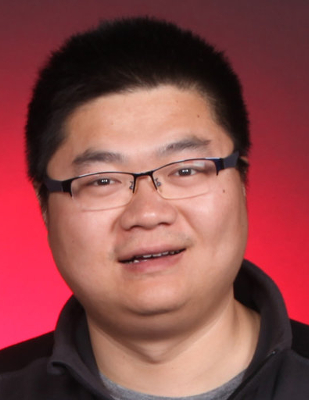 Wenlei Wang is an associate professor in the field of Mineral Resources Quantitative Assessment and Geo-information Analytical Methodology at the Institute of Geomechanics, Chinese Academy of Geological Sciences. He obtained his PhD at York University, Canada in 2013. After that, he came back to China and worked in China Geological Survey. With his geology background and skills of spatial information technology, his records include: proposing “fault trace-oriented” and anisotropic singularity index estimation algorithms, developing “geologically constrained” multi-source data integration model and introducing geographic regression analysis (GWR) model to mineral prediction. He was funded by the grant of Chinese National Natural Science Foundation-Outstanding Youth Foundation in 2018. Since 2019, he is the editorial board member of the journal of Applied Computing and Geosciences.
Wenlei Wang is an associate professor in the field of Mineral Resources Quantitative Assessment and Geo-information Analytical Methodology at the Institute of Geomechanics, Chinese Academy of Geological Sciences. He obtained his PhD at York University, Canada in 2013. After that, he came back to China and worked in China Geological Survey. With his geology background and skills of spatial information technology, his records include: proposing “fault trace-oriented” and anisotropic singularity index estimation algorithms, developing “geologically constrained” multi-source data integration model and introducing geographic regression analysis (GWR) model to mineral prediction. He was funded by the grant of Chinese National Natural Science Foundation-Outstanding Youth Foundation in 2018. Since 2019, he is the editorial board member of the journal of Applied Computing and Geosciences.
Talk title: Geo-information extraction and integration in support of mineral exploration
Scheduled: Tuesday 13:00




